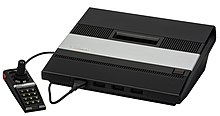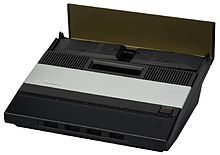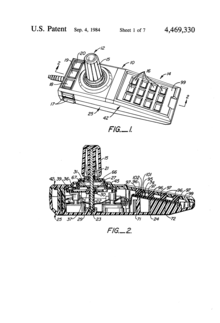Atari 5200
 | |
 Atari 5200 and one of its controllers | |
| Manufacturer | Atari, Inc. |
|---|---|
| Type | Home video game console |
| Generation | Second |
| Release date |
|
| Discontinued | May 21, 1984 |
| Units sold | 1 million[1] |
| Media | ROM cartridge |
| CPU | MOS 6502C @ 1.79 MHz |
| Memory | 16 KB RAM |
| Controller input | Joystick Trak-Ball |
| Predecessor | Atari 2600 |
| Successor | Atari 7800 |
The Atari 5200 SuperSystem or simply Atari 5200 is a home video game console introduced in 1982 by Atari, Inc. as a higher-end complement for the popular Atari Video Computer System.[2] The VCS was renamed to Atari 2600 at the time of the 5200's launch.[3] Created to compete with Mattel's Intellivision, the 5200 wound up a direct competitor of ColecoVision shortly after its release.[4] While the Coleco system shipped with the first home version of Nintendo's Donkey Kong, the 5200 included the 1978 arcade game Super Breakout, which had already appeared on previous Atari home platforms.
The system architecture is almost identical to that of the Atari 8-bit computers, although software is not directly compatible between them. The 5200's controllers have an analog joystick and a numeric keypad along with start, pause, and reset buttons. The 360-degree non-centering joystick was touted as offering more control than the eight-way Atari CX40 joystick of the 2600, but was a focal point for criticism.
On May 21, 1984, during a press conference at which the Atari 7800 was introduced, company executives revealed that the 5200 had been discontinued after less than two years on the market.[5] Total sales of the system were reportedly in excess of 1 million units,[1] far short of its predecessor's sales of over 30 million.
Hardware
[edit]

This section needs additional citations for verification. (February 2014) |
Following the release of the Video Computer System in 1977, Atari began developing hardware for a next generation game console. Instead, it was used as the basis for the Atari 400 and 800 home computers.
Atari later decided to re-enter the console market using the same technology. Prototypes were called the "Atari Video System X – Advanced Video Computer System". Actual working Atari Video System X machines, whose hardware is 100% identical to the Atari 5200 do exist, but are extremely rare.[6]
The initial 1982 release of the system had four controller ports, compared to two in most other consoles. The controllers have an analog joystick, numeric keypad, two fire buttons on each side of the controller, and game function keys for Start, Pause, and Reset. The 5200 also featured the innovation of the first automatic TV switchbox, allowing it to automatically switch from regular TV viewing to the game system signal when the system was activated. Previous RF adapters required the user to slide a switch on the adapter by hand. The RF box was also where the power supply connected in a unique dual power/television signal setup similar to the RCA Studio II's. A single cable coming out of the 5200 plugged into the switch box and carried both electricity and the television signal.
The 1983 revision of the Atari 5200 has two controller ports instead of four, and a change back to the more conventional separate power supply and standard non-autoswitching RF switch. It also has changes in the cartridge port address lines to allow for the Atari 2600 adapter released that year. While the adapter was only made to work on the two-port version, modifications can be made to the four-port to make it line-compatible. In fact, towards the end of the four-port model's production run, there were a limited number of consoles produced which included these modifications. These consoles can be identified by an asterisk in their serial numbers.
At one point following the 5200's release, Atari planned a smaller, cost-reduced version of the Atari 5200, which removed the controller storage bin. Code-named the "Atari 5100" (a.k.a. "Atari 5200 Jr."), only a few fully working prototype 5100s were made before the project was canceled.[7]
Technical specifications
[edit]

- CPU: SALLY @ 1.79 MHz (Custom MOS Technology 6502)
- Graphics chips: ANTIC and GTIA
- Support hardware: 3 custom VLSI chips
- Screen resolution: 14 modes: Six text modes (8×8, 4×8, and 8×10 character matrices supported), Eight graphics modes including 80 pixels per line (16 color), 160 pixels per line (4 color), 320 pixels per line (2 color),[8] variable height and width up to overscan 384×240 pixels
- Color palette: 128 (16 hues, 8 luma) or 256 (16 hues, 16 luma)
- Colors on screen: 2 (320 pixels per line) to 16 (80 pixels per line).[8] Up to 23 colors per line with player/missile and playfield priority control mixing. Register values can be changed at every scanline using ANTIC display list interrupts, allowing up to 256 (16 hues, 16 luma) to be displayed at once, with up to 16 per scanline.
- Sprites: Four 8-pixel-wide sprites, four 2-pixel-wide sprites; height of each is either 128 or 256 pixels; 1 color per sprite
- Scrolling: Coarse and fine scrolling horizontally and vertically. (Horizontal coarse scroll 4, 8, or 16-pixel/color clock increments, and vertically by mode line height 2, 4, 8, or 16 scan lines.) (Or horizontal fine scroll 0 to 3, 7, or 15 single-pixel/color clock increments and then a 4, 8, or 16-pixel/color clock increment coarse scroll; and vertical fine scroll 0 to 1, 3, 7, or 15 scan line increments and then a 2, 4, 8, or 16 scan line increment coarse scroll)[9]
- Sound: 4-channel PSG sound via POKEY sound chip, which also handles keyboard scanning, serial I/O, high resolution interrupt capable timers (single cycle accurate), and random number generation.
- RAM: 16 KB[10]
- ROM:
- 2 KB on-board BIOS for system startup and interrupt routing.
- 32 KB ROM window for standard game cartridges, expandable using bank switching techniques.
- Dimensions: 13" × 15" × 4.25"
Controllers
[edit]

The controller prototypes used in the electrical development lab employed a yoke-and-gimbal mechanism that came from an RC airplane controller kit. The design of the analog joystick, which used a weak rubber boot rather than springs to provide centering, proved to be ungainly and unreliable. They quickly became the Achilles' heel of the system due to the combination of an overly complex mechanical design and a very low-cost internal flex circuit system.[11] Another major flaw of the controllers was that the design did not translate into a linear acceleration from the center through the arc of the stick travel. The controllers did, however, include a pause button, a unique feature at the time.[12] Various third-party replacement joysticks were also released, including those made by Wico.[13]
Atari Inc. released the Pro-Line Trak-Ball controller, which is used for games such as Centipede and Missile Command. A paddle controller[14] and an updated self-centering version of the original controller[15] were also in development, but never made it to market.
Games were shipped with plastic card overlays that snapped in over the keypad. The card would indicate which game functions, such as changing the view or vehicle speed, were assigned to each key.[16]
The primary controller was ranked the 10th worst video game controller by IGN editor Craig Harris.[17] An editor for Next Generation said that their non-centering joysticks "rendered many games nearly unplayable".[12]
Differences from Atari 8-bit computers
[edit]David H. Ahl in 1983 described the Atari 5200 as "a 400 computer in disguise".[18] Its internal design is similar to that of Atari 8-bit computers using the ANTIC, POKEY, and GTIA coprocessors. Software designed for one does not run on the other, but source code can be mechanically converted unless it uses computer-specific features. Antic magazine reported in 1984 that "the similarities grossly outweigh the differences, so that a 5200 program can be developed and almost entirely debugged [on an Atari 8-bit computer] before testing on a 5200".[10] John J. Anderson of Creative Computing alluded to the incompatibility being intentional, caused by Atari's console division removing 8-bit compatibility to not lose control to the rival computer division.[19]
Besides the 5200's lack of a keyboard, the differences are:[10]
- The Atari computer 10 KB operating system is replaced with a simpler 2 KB version, of which 1 KB is the built-in character set.
- Some hardware registers, such as those of the GTIA and POKEY chips, are at different memory locations.
- The purpose of some registers is slightly different on the 5200.
- The 5200's analog joysticks appear as pairs of paddles to the hardware, which requires different input handling from the digital joystick input on the Atari computers
In 1987, Atari Corporation released the XE Game System console, which is a repackaged 65XE (from 1985) with a detachable keyboard that can run home computer titles directly,[20] unlike the 5200.[10] Anderson wrote in 1984 that Atari could have released a console compatible with computer software in 1981.[19]
Games
[edit]Reception
[edit]The Atari 5200 did not fare well commercially compared to its predecessor, the Atari 2600.[21] While it touted superior graphics to the 2600 and Mattel's Intellivision, the system was initially incompatible with the 2600's expansive library of games, and some market analysts have speculated that this hurt its sales,[22][23] especially since an Atari 2600 cartridge adapter had been released for the Intellivision II.[24] (A revised two-port model was released in 1983, along with a game adapter that allowed gamers to play all 2600 games.)[25] This lack of new games was due in part to a lack of funding, with Atari continuing to develop most of its games for the saturated 2600 market.[26]
Many of the 5200's games appeared simply as updated versions of 2600 titles, which failed to excite consumers.[27] Its pack-in game, Super Breakout, was criticized for not doing enough to demonstrate the system's capabilities.[18] This gave the ColecoVision a significant advantage as its pack-in, Donkey Kong, delivered a more authentic arcade experience than any previous game cartridge.[28] In its list of the top 25 game consoles of all time, IGN claimed that the main reason for the 5200's market failure was the technological superiority of its competitor,[29] while other sources maintain that the two consoles are roughly equivalent in power.[30]
The 5200 received much criticism for the "sloppy" design of its non-centering analog controllers.[31] Anderson described the controllers as "absolutely atrocious".[19]
David H. Ahl of Creative Computing Video & Arcade Games said in 1983 that the "Atari 5200 is, dare I say it, Atari's answer to Intellivision, Colecovision, and the Astrocade", describing the console as a "true mass market" version of the Atari 8-bit computers despite the software incompatibility. He criticized the joystick's imprecise control but said that "it is at least as good as many other controllers", and wondered why Super Breakout was the pack-in game when it did not use the 5200's improved graphics.[18]
Popular culture
[edit]Critical to the plot of the 1984 film Cloak & Dagger is an Atari 5200 game cartridge called Cloak & Dagger. The arcade version appears in the movie. In actuality the Atari 5200 version was started but never completed. The game was under development with the title Agent X when the movie producers and Atari learned of each other's projects and decided to cooperate. This collaboration was part of a larger phenomenon, of films featuring video games as critical plot elements (as with Tron and The Last Starfighter) and of video game tie-ins to the same films (as with the Tron games for the Intellivision and other platforms).[32]
See also
[edit]References
[edit]- ^ a b Schrage, Michael (May 22, 1984). "Atari Introduces Game In Attempt for Survival". Washington Post. p. C3.
The company has stopped producing its 5200 SuperSystem games player, more than 1 million of which were sold.
- ^ "The Atari 5200 will be available in October". The Milwaukee Sentinel. September 1, 1982. Archived from the original on March 10, 2023. Retrieved January 12, 2011.
- ^ Barton, Matt; Loguidice, Bill (February 28, 2008). "A History of Gaming Platforms: Atari 2600 Video Computer System/VCS". Gamasutra. Retrieved September 11, 2018.
- ^ G4TV's Icons season 2 episode 1 "Atari"
- ^ Sanger, David E. (May 22, 1984). "Atari Video Game Unit Introduced". New York Times: 3 (Section D).
Company officials disclosed for the first time yesterday that the 5200 is no longer in production, and Atari appears to be selling off its inventory.
- ^ Curt Vendel. "Video System X". Atarimuseum.com. Archived from the original on January 17, 2013. Retrieved January 12, 2011.
- ^ Curt Vendel. "5100/5200 Jr". Atarimuseum.com. Archived from the original on January 17, 2013. Retrieved January 12, 2011.
- ^ a b "Atari 8-bit Forever by Bostjan Gorisek". Archived from the original on July 1, 2017. Retrieved January 1, 2017.
- ^ Wiegers, Karl E. "Atari Fine Scrolling". Retrieved January 1, 2017.
- ^ a b c d Buchholz, Claus (January 1984). "Transporting Atari Computer Programs to the 5200". ANALOG Computing. p. 59.
- ^ "The Atari 5200 Super System". atarimuseum.com. Archived from the original on August 8, 2003. Retrieved July 6, 2014.
- ^ a b "The Next Generation 1996 Lexicon A to Z: 5200". Next Generation. No. 15. Imagine Media. March 1996. p. 33.
- ^ "Atari 5200 Controller Alternatives". www.atarihq.com. Retrieved September 20, 2018.
- ^ Curt Vendel. "Atari 5200 Paddle Controller Prototypes". Atarimuseum.com. Archived from the original on July 3, 2004. Retrieved January 12, 2011.
- ^ Curt Vendel. "Self Centering Joystick Prototypes". Atarimuseum.com. Archived from the original on July 3, 2004. Retrieved January 12, 2011.
- ^ "Atari 5200 overlays". Atari Age. January 31, 2018. Retrieved January 31, 2018.
- ^ "Top 10 Tuesday: Worst Game Controllers". IGN. February 21, 2006. Archived from the original on March 3, 2006. Retrieved December 13, 2019.
- ^ a b c Ahl, David H. (Spring 1983). "Atari 5200 Advanced Game System". Creative Computing Video & Arcade Games. p. 46.
- ^ a b c Anderson, John J. (March 1984). "Atari". Creative Computing. p. 51. Retrieved February 6, 2015.
The games division [..] saw the home computer division as a threat [..] If any of their new machines could expand into true computers, the reins would automatically be handed over [..] To the games division, this was a fate worse than death [so] they chose death. [The 5200 was internally] very nearly an Atari 800 [but] all compatibility and expandability had been designed out [..] If, in 1981, the next-generation game machine had been designed to be compatible with the Atari 400 and 800 microcomputers, Atari would not be in the state it is today. Instead, the 5200 game unit was launched. Internally, it was very nearly an Atari 800, and as such was a fabulous game machine. The notable exceptions were that all compatibility and expandability had been designed out [..] with an external keyboard and 800 compatibility, could have been transformed into a product superior to the famed Coleco Adam, way back in 1982.
- ^ Harris, Neil (May 12, 1987). "Re: Is Atari killing the 8 bit?". Atari Corp. Retrieved June 5, 2014.
So what we have with the XE Game System is essentially a 65XE in disguise. [..] It is completely compatible with the current 8-bit line, including software.
- ^ Moss, Stuart (2007). The Entertainment Industry: An Introduction. CABI. p. 158. ISBN 978-1-84593-551-1.
- ^ Mace, Scott (August 6, 1984). "A New Atari Corp.: The House That Jack Tramiel Emptied". InfoWorld. p. 52. Retrieved January 27, 2011.
- ^ "Atari 7200" (PDF). Electronic Gaming Monthly. No. 91. Ziff Davis. February 1997. p. 97. Archived (PDF) from the original on October 9, 2022.
The 7800 was compatible with the 2600 (but not the 5200) which was the main reason why the 5200 didn't succeed.
- ^ "Atari CX-55 2600 Cartridge Adapter for the Atari 5200 Supersystem". Atari Museum. January 31, 2018. Archived from the original on July 3, 2004. Retrieved January 31, 2018.
- ^ "Atari CX-55 2600 Cartridge Adapter for the Atari 5200 Supersystem". atarimuseum.com. Archived from the original on July 3, 2004. Retrieved July 10, 2016.
- ^ Kent, Steven (2001). The Ultimate History of Video Games. Prima Publishing. p. 230. ISBN 0-7615-3643-4.
- ^ Staff, New York Times (2007). The New York Times Guide To Essential Knowledge: A Desk Reference for the Curious Mind. New York: Macmillan Publishers. p. 472. ISBN 978-0-312-37659-8.
- ^ Kent, Steven (2001). The Ultimate History of Video Games. Prima Publishing. p. 209. ISBN 0-7615-3643-4.
- ^ "Atari 5200 is number 23". IGN. Archived from the original on December 3, 2010. Retrieved January 12, 2011.
- ^ "Colecovision vs Atari 5200 Hardware Comparison". AtariHQ.com. Retrieved January 12, 2011.
- ^ Hubner, John (December 5, 1983). "What Went Wrong At Atari". InfoWorld. p. 148. Retrieved January 27, 2011.
- ^ Parish, Jeremy (August 10, 2015). "Cloak & Dagger, the Video Game Movie That Wasn't About Video Games". USGamer. Archived from the original on November 22, 2021. Retrieved November 21, 2021.
External links
[edit]- AtariAge – Comprehensive Atari 5200 database and information Archived April 21, 2019, at the Wayback Machine
- Atari Museum 5200 Super System section Archived July 23, 2012, at archive.today
Lua error in Module:Navbox at line 535: attempt to get length of local 'arg' (a number value). Lua error in Module:Navbox at line 535: attempt to get length of local 'arg' (a number value). Lua error in Module:Navbox at line 535: attempt to get length of local 'arg' (a number value).
